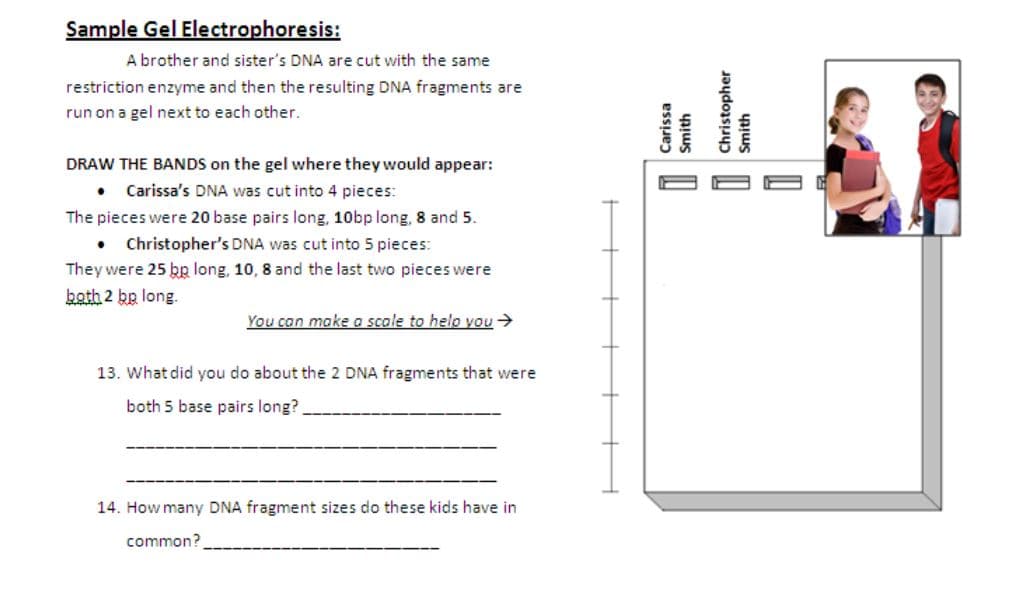Sample Gel Electrophoresis: A brother and sister's DNA are cut with the same restriction enzyme and then the resulting DNA fragments are run on a gel next to each other. DRAW THE BANDS on the gel where they would appear: • Carissa's DNA was cut into 4 pieces: The pieces were 20 base pairs long, 10bp long, 8 and 5. • Christopher's DNA was cut into 5 pieces: They were 25 bp long, 10, 8 and the last two pieces were both 2 bp long. You can make a scale to helo you → 13. What did you do about the 2 DNA fragments that were both 5 base pairs long?. 14. How many DNA fragment sizes do these kids have in common? Carissa Smith Christopher
Sample Gel Electrophoresis: A brother and sister's DNA are cut with the same restriction enzyme and then the resulting DNA fragments are run on a gel next to each other. DRAW THE BANDS on the gel where they would appear: • Carissa's DNA was cut into 4 pieces: The pieces were 20 base pairs long, 10bp long, 8 and 5. • Christopher's DNA was cut into 5 pieces: They were 25 bp long, 10, 8 and the last two pieces were both 2 bp long. You can make a scale to helo you → 13. What did you do about the 2 DNA fragments that were both 5 base pairs long?. 14. How many DNA fragment sizes do these kids have in common? Carissa Smith Christopher
Human Heredity: Principles and Issues (MindTap Course List)
11th Edition
ISBN:9781305251052
Author:Michael Cummings
Publisher:Michael Cummings
Chapter14: Biotechnology And Society
Section: Chapter Questions
Problem 9QP
Related questions
Question
100%

Transcribed Image Text:Sample Gel Electrophoresis:
A brother and sister's DNA are cut with the same
restriction enzyme and then the resulting DNA fragments are
run on a gel next to each other.
DRAW THE BANDS on the gel where they would appear:
Carissa's DNA was cut into 4 pieces:
The pieces were 20 base pairs long, 10bp long, 8 and 5.
Christopher's DNA was cut into 5 pieces:
They were 25 bp long, 10, 8 and the last two pieces were
both 2 bp long.
You can make a scole to helo you>
13. What did you do about the 2 DNA fragments that were
both 5 base pairs long?
14. How many DNA fragment sizes do these kids have in
common?
Carissa
M Christopher
Smith
Expert Solution
This question has been solved!
Explore an expertly crafted, step-by-step solution for a thorough understanding of key concepts.
This is a popular solution!
Trending now
This is a popular solution!
Step by step
Solved in 2 steps with 1 images

Knowledge Booster
Learn more about
Need a deep-dive on the concept behind this application? Look no further. Learn more about this topic, biology and related others by exploring similar questions and additional content below.Recommended textbooks for you

Human Heredity: Principles and Issues (MindTap Co…
Biology
ISBN:
9781305251052
Author:
Michael Cummings
Publisher:
Cengage Learning

Human Heredity: Principles and Issues (MindTap Co…
Biology
ISBN:
9781305251052
Author:
Michael Cummings
Publisher:
Cengage Learning